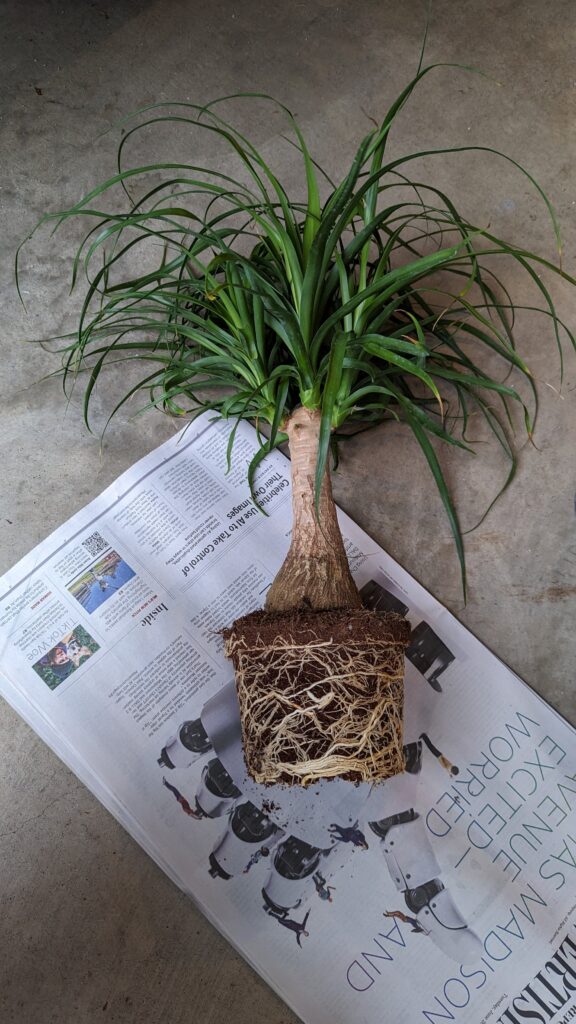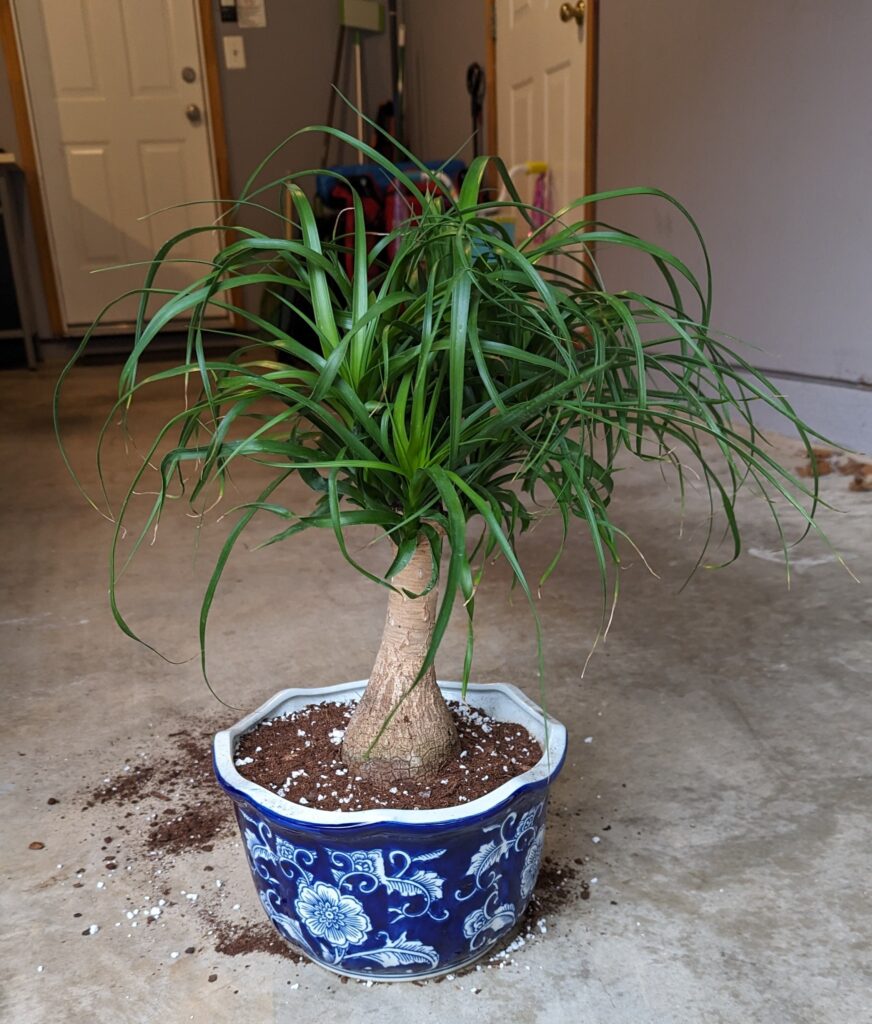Ponytail Palms are cute palm-like plants, but their leaves are long and thin. Ponytail Palms can actually grow very tall, although it takes ages, but they look quite neat. They are generally pretty easygoing plants, which can make it harder to determine if they need any extra care. When repotting, people often wonder if their Ponytail Palm needs a specific soil. Follow along in this post to learn about some signs that it’s time to repot your Ponytail Palm and what type of soil to use.
About Ponytail Palm
The Ponytail Palm is sometimes called a Pigtail Palm or Elephant’s Foot plant. It has a bulbous trunk lower towards the soil. The trunk holds water because its native habitat has long dry seasons. The leaves are a deep green that are thin and swordlike although they can also be a bit curly as well. The Ponytail Palm is considered an easier houseplant because they have relatively low water and fertilization needs and can deal with not having the brightest light. I have kept mine near a south-facing window and it’s been pretty happy there.
| Light Needs | Watering Needs | Soil Needs | Fertilizing Needs |
| Bright to moderate direct light. | Let soil dry completely between waterings. | Well-draining potting soil. | A few times per growing season. |
In terms of care, the thing you probably want to watch out for is overwatering your Ponytail Palm. They don’t do not like moist soil. A bonus is that Ponytail Palms are not toxic to dogs and cats. I still don’t recommend that you to let your pets chew on it though.
Does My Ponytail Palm Need to be Repotted?
Roots are Bound or Showing
If you can see the Ponytail Palm’s roots either out of the bottom of the pot or out of the top of the soil, that’s a sign that you should repot it. When roots are growing out of the pot that is a definitive sign that the roots need more room and more soil to grow into. A bigger pot with more soil will provide new nutrients and the ability to hold more moisture. My Ponytail Palm had roots growing out of the bottom of the pot (See picture below). In addition, the roots had filled out the old pot and began circling and crowding each other. Because of this, it was evident I needed to repot my Ponytail Palm.

Yellow Leaves
If your Ponytail Palm has leaves that have begun to yellow, that can be a sign of watering issues. Ponytail Palms often yellow from tip first, and the tips of Ponytail Palms are so thin and delicate. If the leaves are sagging and appear limp, then your plant probably needs a drink. Lack of moisture can definitely be the cause of leaf yellowing. Your Ponytail Palm may also require a repot. For example, plants/pots can dry out too quickly between waterings due to lack of soil, which holds moisture. Yellowing leaves can also be caused by overwatering. If you realized you’ve been frequently overwatering your Ponytail Palm, it’s probably a good idea to repot it. For one, you may have washed away a lot of nutrients out of the soil from overwatering, and second, you probably need more well-draining soil. A cheap tool to keep track of your soil moisture is a soil moisture meter. I use mine multiple times a week.
Ponytail Palm Soil
Ponytail Palms don’t need any specialized formula for Ponytail Palms. If you’re going for a premade mix, one geared towards cacti will work well. Otherwise , if you’re using regular potting soil, which is also fine, make sure it’s well draining. Most potting mix has perlite which will help with draining, but you can also add a little extra as well. You want to steer away from any soil or mix that retains moisture. Soil heavy on peat will keep moisture and can lead to root rot. The Ponytail Palm has that thick trunk specifically for storing water so it does not need overly moist soil.
Repotting a Ponytail Palm
If you’re sizing up, the new pot should be about one to two inches in diameter larger than your old pot. If you are repotting for aesthetic reasons or because of moisture-related issues, then select a pot that is two inches in diameter larger that the root ball. Your new pot must have drainage holes, because Ponytail Palms like to dry out in between waterings. If you need to add drainage holes to your pot follow my tutorial on drilling ceramic and glass plant pots.
To begin repotting your Ponytail Palm, first remove it from its old pot. You always want to be careful when working with the roots, but Ponytail Palms don’t have especially delicate roots. Once it is out of the pot, it’s a good idea to inspect the roots. You don’t get to see the roots often, so you might as well give them a good once over. Healthy roots are white and plump. Diseased roots are brown and mushy. If they are brown or mushy, follow up with my blog on overwatering for steps to address that.

If your root ball is tightly wound, you can try to loosen it a bit which can help the roots grow in a better pattern rather than circling. Fill your pot with soil to the height where you want the bottom of the root ball to sit, you can cover the drainage holes with paper towel to keep the soil from falling out of the bottom of the pot too. Place the root ball on the soil, then fill in the sides of the pot while you hold the Ponytail Palm in place. Ponytail Palms are a plant that you want to make sure you have it planted vertically or else it will look like it’s leaning and the trunk grows so slowly it won’t correct very quickly. See the after photo above of my most recent repotting.
After Repotting
Repotting can be a very shocking event for your plant. If you loosened up the root ball, that can definitely give it a shock. After a shock, you want to avoid further shock for a week or two. That will eliminate further disruptions. Avoid moving your Ponytail Palm to a new spot after repotting. That can be tough if you just brought it home from the store. It’s beneficial to try and provide it with the same light, humidity, and other environmental factors immediately following a repot. I also recommend waiting a few days to water it. Once you do start watering remember that you have a lot more soil if you upsized the pot, and that soil holds more moisture. Hopefully after you take it easy for a week your Ponytail Plam will enjoy its new pot.
If you have any other Ponytail Palm questions, put them in the Comments section.

I'm a long time plant lover on the quest to happily coexist with as many plants as I can. Let's grow!
